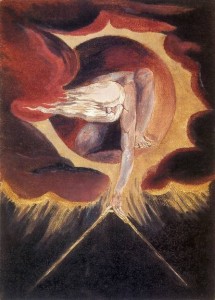
by Mark Turner –
When we see elements of our vision in other people’s lives, it confirms our mission, especially when we see them in people’s lives back through past ages. That is where we connect with world history.
The differences in our expressions of these inspirations today are our contribution to the on-going enlightenment (salvation) of humanity. Our commonality with people regardless of time, place and culture is an indication of what God is creating and of our destiny.
That’s How Blake Comes In Here
When I painted a work in 1973 based on the phrase “Holy is imagination, the gateway of reality into our hearts,” I did not realize I was carrying on a mission espoused by William Blake in the late 18th and early 19th centuries.

Blake was a contemporary of John Wesley and the accompanying spiritual revival. It was the “Age of Reason” when the definition of truth tended to be only what is observable in the natural world. Even the Church was dominated by reason, rather than by faith. Through his art Blake struggled to show that faith was not negated by reason. Like Wesley and the Methodists to follow, he sought a balance where reason supported and served faith rather than “disproved” it. He held that imagination was God’s gateway to the larger reality beyond the material, observable world.
A New Book On Blake!
While house sitting for friends, one an artist and the other a theologian, I discovered a freshly published book by another friend of theirs, Jennifer G. Jesse, entitled William Blake’s Religious Vision: A Methodism to His Madness.
Reading the book I began to realize the following points of theology, philosophy and personal mission which I hold in common with Blake.
1. Faith and reason serve one another
Like the Methodists, Blake held that reason bolsters faith by revealing the expansiveness of God while faith guides reason into the mysteries of God. We in Horizon Gate also pursue that balance in which the spiritual contemplative gives rise to action in the material world. The seeds and roots of our art are in our spiritual life and the objects of art are as fruit for the world.
2. Imagination is a sacred gift as a vehicle of faith
Blake’s answer to rationalism and unbelief was that our ability to imagine beyond empirical evidence was itself evidence of a larger reality.

Like Blake we use imagination as a vehicle of faith which assists us to hold the impossible as possible. In this capacity it is the prophetic impulse of the artist; it is the avenue which even scientists utilize toward expanding creation — the unity of the spiritual and the material.
3. The goal of our art is the audience’s action
Blake would create works with which the viewer was required to interact, or to see themselves in the art. Like him we employ various techniques that make the audience/viewer study, discuss and participate in the work. We do not aspire to create escapist entertainment which immerses the audience in the superficial.
4. The viewer “customizes” art to their personal needs
Blake would use the viewpoints and language of those to whom he appealed in order to gain entry for the work into their inner thoughts. He was even known to create works with backwards text so that his viewers would have to use a mirror to read it and thus to see themselves as part of the works. Like him, we provide room for each individual in our audience to personalize, think and converse about what they are perceiving. In this way they apply our works to help in their personal journeys.
5. We CAN act as personal collaborators with God
Blake was influenced by the revivals both of his day and of previous years (the Wesleys and Moravians) in which personal experiences of relationship and collaboration with God were valued. Believers were encouraged to share with others the spiritual illumination from their communion with God. Thus it was normal for Blake to have a certain zeal in his art to draw people toward God. This has always been our personal assumption about our artistic mission as well. For us the spiritual revivals over the long span from the 15th through the 20th centuries have been passed to us directly through family, culture and the Church. We see ourselves in the ancient tradition of the Old Testament prophets responsible to express what the Spirit is saying, to radiate God’s presence.
To find artistic and spiritual kinship with a great artist long before our time is a gift from above through all the art historians, theologians and curators who preserved Blake’s legacy. Blake’s perseverance in poverty conditions and repeated rejections calls us all to be diligent in our own crafts, in our spiritual health and in our assistance of one another on this grand mission of Creation.
We are all invited to be partners with God and each other, not just by-standers, or passive recipients in the on-going progression of Creation.

